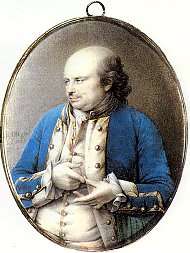The Graeme Park Story Behind Edward Lamson Henry’s Painting, “Drafting the Letter”

Edward Lamson Henry painted “Drafting the Letter,” the painting in the photo at left, in 1871. You may recognize certain elements in the room as being similar to the master bedroom in the Keith House at Graeme Park.
In fact it is based on this room – Henry painted what was called “historic fiction,” so he based his paintings on real spaces but reinvented them to suit his artistic vision. An avid collector of 18th century furniture, he also envisioned the space with pieces from his collection. The subject of the painting was based on a description of an incident in Elizabeth Graeme’s life that Elizabeth F. Ellet wrote about in her book, The Women of the American Revolution.

While in Philadelphia to take leave of her husband, who was embroiled in the Revolutionary War, Elizabeth stayed in the home of Charles Stedman. The Stedmans were also entertaining George Johnstone, a Commissioner sent by the British to settle the differences between England and America. Johnstone requested of Elizabeth that “should she see” General Joseph Reed that she might suggest to him that should he “conformably to his conscience and views of things” bring about the settlement of the dispute between England and her colonies that he might “command 10,000 guineas and the best post in the government.” Elizabeth expressed her concerns that Reed might view this as a bribe and that were he in favor of giving up independence he would say so without personal gain, but Johnstone convinced her it was part of the normal negotiation process.

Elizabeth requested a meeting with Reed, allegedly to discuss her loyalist husband Henry’s situation, and, when he mentioned having recently received a letter from Johnstone, conveyed to him the conversation she had with him, assuming the letter had similar content. Reed’s indignant reply was “I am not worth purchasing; but such that I am, the King of Britain is not rich enough to do it.” General Reed brought the matter to Congress, conveying both the conversation with Elizabeth and a letter he had received from Johnstone. He did keep Elizabeth’s name out of it, but the details were such that in an account published in the newspapers, suspicion was immediately drawn to Elizabeth. When Elizabeth saw the article in Towne’s Evening Post she immediately “drafted a letter” to General Reed complaining of having been made to look like Johnstone’s pawn.

“I find it hard, knowing the uncorruptness of my heart, to be held out to the public as a tool to the commissioners. But the impression is now made, and it is too late to recall it. How far, at this critical juncture of time, this affair may injure my property, is uncertain; that, I assure you, is but a secondary thought.” The writing of this response is the subject of Henry’s painting, and her fear for Graeme Park was real, as the property was confiscated due to her husband’s loyalties. The exchange with Reed, which continued on with more back and forth in the papers, left him an enemy while his position in the Pennsylvania Supreme Executive Council gave him great influence over the restoration of her property.

